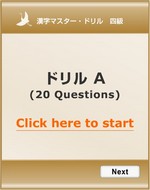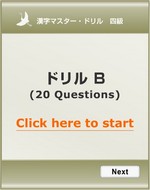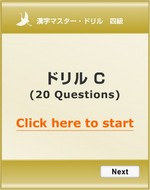Part 3: 時 分 半 前 後 午 間 行 会 社
Read this page briefly and spend most of your time on the drill exercise for quick memorization.
時 : ジ、とき
Meaning: time Shape: 日 + 寺
|
Click to see the stroke order animation.
| Word | Reading | Meaning | Class |
|---|---|---|---|
| ~時 | ~じ | _ o'clock | suffix |
1時<1 o'clock>, 2時<2 o'clock>, なん時<what time?> Note the following irregular pronunciations: 4時(よじ not よんじ), 7時(しちじ not ななじ), 9時(くじ not きゅうじ) |
|||
| 時[々] | ときどき | sometimes | adv |
It is actually two 時. When the same Kanji is repeated twice, the mark 々 is used for the second one. Another example: 日々(ひび)< days> |
|||
| 時[計] | とけい | clock | n |
| ~時 | ~とき | at the time of _, when _ | n |
おきた時、あめが ふっていました。<It was raining when I woke up.> |
|||
分 : フン、ブ、ブン、わ(かつ)、わ(かる)、わ(かれる)、わ(ける)
|
Meaning: to divide, minute Shape: 八 + 刀(sword). Being cut into two pieces by a sword - symbolizing the concept "to divide".
|
| ~分 | ~ふん | _ minute(s) | suffix |
1分<1 minute>, 2分<2 minutes>, なん分<how many minutes?> ~分 can be used for telling time and for duration. Note the following irregular pronunciations: 1分(いっぷん), 3分(さんぷん), 4分(よんぷん), 6分(ろっぷん), 8分(はっぷん), 10分(じゅっぷん). |
|||
| 分かる | わかる | to understand | v |
分かりますか。<Do you understand?> 分かりません。<I don't understand.> This word is written all in Hiragana more often. |
|||
半 : ハン、なか(ば)
|
Meaning: half
|
| ~半 | はん | _ (and) half | n |
1時半(half past 1), 2時間半(2 and half hrs), 3か月半(3 and half months) |
|||
| 半分 | はんぶん | half | n |
前 : ゼン、まえ
|
Meaning: in front, before
|
| 前 | まえ | in front | n |
えきの 前に ホテルが あります。<There is a hotel in front of the station.> |
|||
| ~前 | ~まえ | _ ago, _ before | n |
1分前<1 minute ago>, 2日前<2 days ago>, なんか月前<how many months ago?> |
|||
後 : コウ、ゴ、あと、うし(ろ)、おく(れる)、のち
|
Meaning: after, back, behind
|
| 後 | あと | afterwards, later | n |
また 後で。<See you later.> |
|||
| 後ろ | うしろ | back, behind, rear | n |
後ろから くるまが きます。<A car is coming from behind.> |
|||
| ~後 | ~ご | after _ | n |
1分後<after 1 minute>, 2日後<after 2 days>, なんか月後<after how many months?> |
|||
Notes
前 and 後 are used for time and for space.
午 : ゴ
|
Meaning: noon
|
| 午前 | ごぜん | a.m., morning | n |
午前8時<8 a.m.> |
|||
| 午後 | ごご | p.m., afternoon | n |
午後6時<6 p.m.> |
|||
間 : カン、ケン、あいだ、ま
|
Meaning: between, span Shape: 門(gate) + 日(day)
|
| 時間 | じかん | time | n |
時間が ありません。<There is no time.> |
|||
| ~時間 | ~じかん | _ hours | suffix |
一時間<1 hour>, 二時間<2 hours>, なん時間<how many hours?> Note the following irregular pronunciations: 4時間(よじかん), 7時間(しちじかん or ななじかん), 9時間(くじかん) |
|||
| ~間 | ~かん | duration | suffix |
間 can be used in other units. 1分間<1 minute>, 2日間<2 days>, なんか月間<how many months?> |
|||
行 : アン、ギョウ、コウ、い(く)、おこな(う)、ゆ(く)
|
Meaning: to go, to do
|
| 行く | いく, ゆく | to go | v |
There are two ways of reading いく and ゆく. いく is used more often. |
|||
| [銀]行 | ぎんこう | bank | n |
| [飛]行[機] | ひこうき | airplane | n |
| [旅]行 | りょこう | travel | n |
会 : エ、カイ、あ(う)
|
Meaning: to meet, to see
|
| 会う | あう | to meet, to see (someone) | v |
社 : シャ、やしろ
|
Meaning: Shape: ネ + 土
|
| 会社 | かいしゃ | company, corporation | n |
Writing Practice
Printable writing practice sheet is available at Kanji Writing Practice page.
Meaning of Kanji
Each Kanji symbol expresses its meaning.
Kanji symbols containing the same component tend to have similar meanings.
- 火(fire): 炎(flame), 燃(burn), 煙(smoke), 灰(ash), 爆(burst)
- 木(tree): 森(forest), 枝(branch), 桜(cherry), 松(pine), 棒(stick)
- 金(gold): 銀(silver), 銅(copper), 鉄(iron), 鎖(chain), 針(needle)
Many of Kanji words are made based on the meaning of the component Kanji symbols.
- 大(big) + 人(person) = 大人(adult)
- 電(electric) + 話(talk) = 電話(telephone)
- 新(new) + 聞(hear) = 新聞(newspaper)















